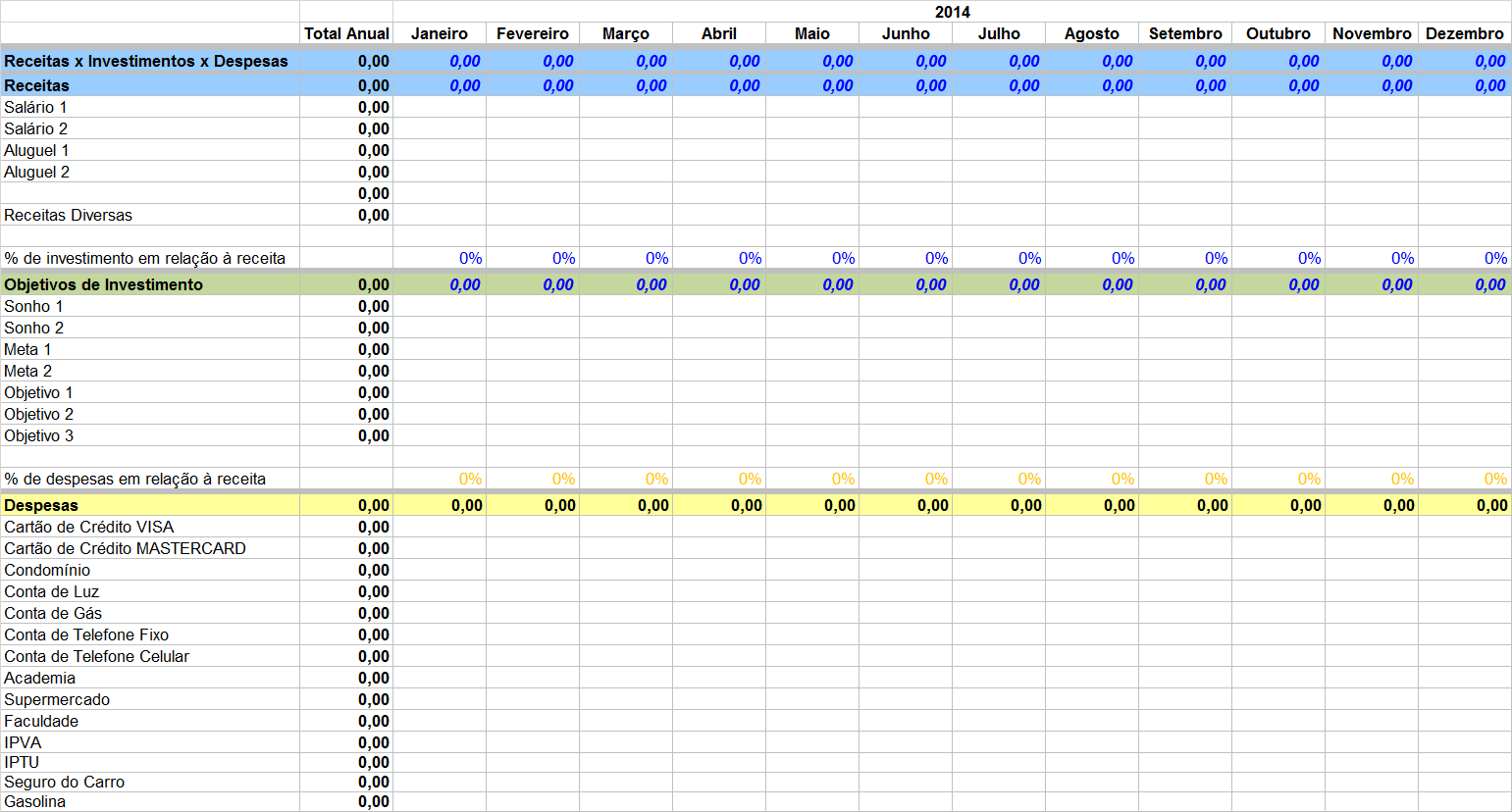The biggest challenge of all time is, undoubtedly, make the salary that lasts until next month!
Jokes aside, Financial education is something that should be taught by parents, reinforced at school and applied in our daily lives.
This post is an extension ofpersonal budget control I wrote in July 2010, almost four years ago. The basis of my control budget has remained the same since that time, but some concepts evolved enough and decided to show you what improved from there to here.
Before posting the link to the budget worksheet should I start explaining about what I understand personal budgeting. Let the explanation:
What is Personal Budget?
For me personal budget is to administer the sacrifices (expenditure) towards our dreams (investments).
My reasoning regarding raising money changed significantly after li Smart Investments Gustavo's Cerbasi. While reading this book I came to put a well-reflexive sentence in my twitter:
 This loose sentence, no explanatory basis, may confuse more than help, but, basically, indicates we should always prioritize our goals, dreams and goals when we are planning your personal budget. If we focus only on gathering money left over at the end of the month, this money may not be enough for us to achieve our dream of making that international travel, to purchase the long awaited home, replacing drive, to pay the wedding party etc.. Every dream has its, but certainly some of these will need money to be made.
This loose sentence, no explanatory basis, may confuse more than help, but, basically, indicates we should always prioritize our goals, dreams and goals when we are planning your personal budget. If we focus only on gathering money left over at the end of the month, this money may not be enough for us to achieve our dream of making that international travel, to purchase the long awaited home, replacing drive, to pay the wedding party etc.. Every dream has its, but certainly some of these will need money to be made.
When you go to place your dreams above their actual expenses, you begin to significantly change your financial behavior.
I'm not saying to stop paying the electric bill and save that money. I'm not saying to walk 10km to work to save the bus fare. I'm also not saying to cut the theater, film and all meetings with friends to join more money. That's not what I'm talking about.
As I said in the post personal budget control, the goal is to have notion of the amount of money we earn, the amount we spend and, the main, that is Unsurprisingly learned after reading Smart Investments, is that we must define how much money we should join to buy the much desired dream.
This means that sacrifices have to be made to achieve these goals. The proposal that my personal budget spreadsheet is that your dreams come above your expenses and you do everything possible to achieve it. If your dream is to travel in two years and this trip will cost you about £ 20mil, plan to join R $ 830.00 per month and manage all your expenses to remain this value at the end of the month.
Saving energy and saving money involves responsible consumption, review of spending and changing habits to optimize the most of your shopping and meet their needs. No use spending all your money buying new clothes at the mall and then say they can not fulfill their dreams because they never spare money at the end of the month.
I think you get the idea that the main concept of the post that is: prioritize your dreams. I can not dwell longer on this subject because eventually fleeing the main focus which is the personal budget spreadsheet.
Personal Budget Worksheet
My spreadsheet is very simple to be updated and you even could have created a similar version, because basically consolidates all the recipes you get in the month, all the money you need to put together monthly to achieve their dreams and, por fim, all the expenses that you leave them farther.
Then, when you open the spreadsheet you will see three big consolidators areas, are:
- Recipes;
- Investment Objectives (our dreams); and
- Expenses.
It may seem strange that I have put the words “revenue” and “dreams” not plural, but many people make money by more than one source of payment (salary, rental property, loans to relatives etc..) and do not advise to have only one dream. International travel and home ownership dreams are long-term, but spend a weekend in a nice inn or buying an electric bike can be intermediaries dreams that encourage you to stay focused on short-term rewards (after all, nobody is iron!).
Regarding item “expenditure” plural believe has not generated any doubt, correct? Light Conta, condominium, Invoice Credit Card, gasoline, insurance, Property tax, IPVA, college tuition, pizza with friends, BBQ get-together etc.. Expenses are always the easiest to list. Below you can already see how this worksheet is structured:
Structure of Personal Budget Worksheet
*Click on the image to see it full size.
How can you repair, lines represent revenues, investments and expenses and the columns representing the months. Below I detail each of these lines:
- Recipes x x Investment Expense: this line will indicate you if your budget is in the red (wide) ou azul (good). The calculation is quite simple, it is the sum of all revenue, less the sum of all investments, less the sum of all costs.
The trick I use a lot in this cell is that the whole month end value here has to be zero. This means that my income covered all my dreams and also my expenses. - Recipes: is the sum of all revenues every month.
- % investment to revenue: this is an indicator that shows what percentage of their revenues being intended for your dreams. The higher the better indicator, it means that you will reach your dreams faster.
- Investment Objectives: Here you list all your dreams!
- % expenditure to revenue: in contrast with the investment, This shows the percentage of money you allocate to pay their expenses. The goal is always to decrease this indicator. Of course it will never reach zero, Since we always have bills to pay pra, but it shows you if your life is exaggerated profligacy.
- Expenses: Here you list all your monthly payment commitments, in other words, everything that makes you more distant from your dreams.
- Column of the Month (January to December): I prefer to have a budget planned for year, but you can adapt the worksheet to your needs.
This is basically the structure of the worksheet and, used for the, you must fill, month after month, the predicted values for each recipe, dream and spending.
This post was pretty big and I decided to split it into two. Next explain in more detail how do I control my personal budget, with tips for controlling the execution of the budget and techniques of visual marking to indicate a payment made, scheduled payment, revenues already received etc..
I hope this post has taught you a bit about personal control budget and you already start testing the concept in their day to day.




 Personal.xls Budget Worksheet
Personal.xls Budget Worksheet





